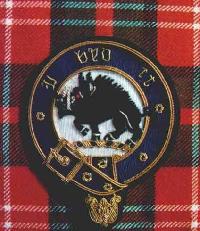
The Nesbit Tartan and crest
Gospatric I died about 1120 A.D. His son and successor, Gospatric II, Second Earl of Dunbar and March, lived during the reigns of Alexander I (1107-1124) and David I (1124-1153) of England. Gospatric II was required (under protest) by David I to grant to the church in Coldingham a portion of his lands under the name NESEBITE. The grant was confirmed by King David I on Sept. 17, 1139. On that day the name of Nesebite, later Nisbet and then Nesbit, became entered into the official record, probably for the first time.
A Name Recorded (1120 - 1139)
Gospatric I died about 1120 A.D. His son
Gunhilda, daughter of Gospatric I and sister of Gospatric II, married the son of a Norseman named Ketel in 1085. The son's name was probably Thor Longus (as it was entered in the Domesday Book, the first western census). The two had a son -- Crin, or sometimes recorded as Crinan -- who became the father of two sons. One of the sons, Aldan, was born in 1113.
Crin was an educated man and had been appointed collector of dues at Prendergest. Aldan succeeded him in that post and later became an advisor to his brother, who was by then Earl of Dunbar and March. Gospatric II had protested against the transfer of Nisbet lands to the church, and in deference to Aldan's family position an agreement was reached that gave Aldan and his heirs perpetual right of tenancy on the Nisbet lands, with the exception of the claim and duty of the monks of St. Cuthbert.
In view of that agreement, Aldan became Aldan of Nisbet, and by extension the patriarch of the Nisbet family.
He was my 20th-great grandfather.
captured villages and places. The exceptions were the two forts. The present town of Duns, therefore, has a name that dates to the early centuries of Christianity and is among the oldest names in Scotland.
Following the death of the last of the Northumbrian kings in 926 came the rule of King Athelstan and his successors. A nephew, King Edgar, granted Edinburgh to Indolph, King of Scots, and later granted him the province of Lothian. More lands were given to Indolph's successors. These Scottish kings were descended from the monarch Kenneth I who is credited with establishing the Rule of Scots. The affect of these grants was to bind the King of Scots and all his heirs to pay homage to the King of England.
All the land between the Forth and Tweed rivers was subsequently granted to Kenneth I's successor, Kenneth II. Kenneth II sought to change the ancient law of royal succession (which allowed his people to choose their king from among royal blood) and forced them to recognize his son Malcolm as king, a plan that met broad opposition. Instead, the Scots recognized Kenneth III, who was on the Scottish throne in 1005 when he was slain by Malcolm II, who replaced him and remained king until his natural death in 1034.
Malcolm II had no son, so he left Scotland to his eldest daughter, who had two sons: Duncan and Maldred. The former became King Duncan I of Scots in 1034, and was killed in battle against McBeth near Elgin in 1040. Duncan became the father of Falcolm III, King of Scots from 1054 to 1093. Maldred married the grand-daughter of King Ethelred of England. They named their eldest son Gospatric.
Gospatric was aggressive and ambitious. In 1069, using forces raised in Scotland and with the help of some Danes, Gospatrick invaded England and took the city and castle of York. With royal allies, he later raided Cumberland in England, taking huge amounts of plunder. These raids continued for some time, but eventually Gospatric grew weary of the constant dangers he faced from his raids and other exploits and eventually withdrew to the ancient stronghold of Bamborough, the seat of the earls of Northumberland. He apparently liked Bamborough so much that he decided to claim the earldom of Northumberland by right of ancestry, and offered England a large sum of money to "grease the royal wheels."
William the Conqueror, then on the throne of England, denied Gospatric his earldom. That and a new-made peace between Scotland and England meant Gospatric could no longer resort to warmaking and raids. Gospatric went away for a time, and upon his return a sympatheic King Malcolm III of Scots, his uncle, bestowed on Gospatric the fortress and castle of Dunbar. He thus became the first Earl of Dunbar and March (it was to that castle of Dunbar that Mary Queen of Scots was taken in 1567 when she was abducted by Bothwell).

The Nisbet Castle, located near Duns in Berwickshire, southeast of Edinburgh
A Family Founded (547 - 1120)
The British Isles, particularly Scotland and Ireland, from shortly after the time of Christ were inhabited by a race known as the Caledonians. In Eastern Scotland during the first half of the 1st millenium A.D., the Caledonians erected two primary forts as protection from the sea: One on the Haddington Coast known as Dunbar, the other near the center of the shire of Berwick known as Duns.
In the year 547 A.D., Saxon invaders led by Ida the Flame Bearer took possession of and occupied all territory south of the Firth of Forth on the North Sea coast. By 617 A.D. King Edwin of the Northumbrians, a successor to Ida, had established Edwin's Burgh, which he named for himself and today is the great city of Edinburgh.
As the Saxon hold on the region grew stronger, the occupiers gave names of their own to the
From left, Susan, Craig, Katie and husband Drew, Chris and wife Kristie in the namesake village of Nisbet in Scotland, about 75 kilometers southest of Edinburgh.
Line of the Nisbets of Greenholm (1085 - 2004)
Thor Longus, possibly the son of Ketel, married in 1085, father of ...
Crin, sometimes known as Crinan, father of ...
Aldan of Nisbet, (1113-1180), first of the name and patriarch of the Nisbet Clan, father of ...
Thomas of Nisbet, Prior of the Monastary of Coldingham from 1219-1240, father of ...
Robert of Nisbet, of East Nisbet, father of ...
Robert of Nisbet, knighted by KIng Edward II of England, in 1285, father of ...
Thomas Nisbet, of East Nisbet, died in 1295, father of ...
Adam Nisbet, killed in the first Battle of Nisbet, father of ...
Adam Nisbet, lived in West Nisbet from 1364 to 1372, father of ...
Philip Nesbit, (1332-1402) killed in the second Battle of Nisbet, father of ...
Robert Nisbet, died in 1424, father of ...
James Nisbet, born in the 15th century, lived in Ayrshire, Scotland, father of ...
Murdock Nisbet, (1470 - 1558) of Hardhill, Scotland, first of the branch "Nisbets of Greenholm," one of seven Nisbet branches; wrote by hand a complete translation of the New Testament into Gaelic, which he completed in 1510 and which now resides in the British Museum in London; father of ...
Alexander Neisbet, left as heir to the Nisbet New Testament, father of ...
James Nisbet, born in 1602 in Lanarkshire, Scotland; father of ...
Capt. John Nisbet The Martyr, (1627 - 1685); much has been written about John Nisbet, who has suffered great religious persecution because of his fervent belief in the tenets of the reformation; after taking arms against the Church and King, he spent years as a fugitive, his lands and belongings confiscated; he was hung by the neck at Edinburgh Castle on Dec. 4, 1685; father of ...
James Nisbet, (1667 - 1728), became military governor of Edinburgh Castle, the residence of Scottish Kings since 1059 and the place of his father's execution; wrote "The Private Life of the Persecuted" about his father in 1719, and later his own memoirs; married Agnes Woodburn, who bore him two children; father of ...
John Nisbet, (1705 - 1755) came to America in 1731, landing at Philadelphia; pushed westward into Pennsylvania, and then south along the Appalachian ridge; finally settled in Lancaster County, South Carolina. Moved to Rowan County, North Carolina in 1753, died Nov. 19, 1755; buried in Thyatira Churchyard; father of ...
Alexander Nisbett, (1731 -1773) born at sea; married Agnes Ramsey and had nine children; on Feb 20, 1755 received a land grant for 390 acres in Anson County, S.C., and an additional 100 acres on Nov. 6, 1770; became a prosperous farmer; father of ...
Joseph Nisbet, eighth child and youngest son of Alexander Nisbett, born about 1770 and died about 1825; at about the age of 10, he served as a horseman in Col. William Nisbet's regiment (Joseph's brother) from June 15, 1780 through June 1, 1781; engaged in the battles of Rocky Mount, Hanging Rock and of Camden, S.C.; married Elizabeth McMurray, settled in Lancaster County and had nine children; father of ...
Joseph (Josiah) Nisbett, and his wife Mary, lived in Waxhaw, Union County, N.C. He left Waxhaw for "the west" in 1849 in search of gold -- a true '49er -- and was killed in a mine when a bucket fell on him; Josiah and Mary had one child, a son, born after Josiah departed to seek his fortune; father of ...
Albert Lafayette Nesbit, the only child of Josiah and Mary Nisbett, born in November 1849 near Waxhaw, N.C., near Concord; Married Nancy Ladarkus Gray of Cabaruss County and had seven children; father of ...
John Franklin Nesbit, the last born of Albert and Mary Nisbett on July 27, 1891, in Concord, N.C.;Lived in Charlotte until 1918 when he moved to Norfolk, Va.; worked for the federal government there; father of ...
John Franklin Nesbit Jr., born March 25, 1926 in Norfolk, Va.; served in World War II as an infantryman in Gen George Patton's 3rd Army; wounded in Belgium; returned to Norfolk and married Shirley Mann Smith; had three children, became a railroad agent; later moved to Orange County, Fla.; father of ...
Craig Emerson Nesbit, (1955 - ) born in Norfolk, Va.; graduated from Virginia Tech; married Susan Kay Barber of Chesapeake, Va. in 1976; had two children; newspaper journalist and editor in Virginia and North Carolina; later lived and worked in Arizona and Chicago as a strategic communications executive; father of ...
Christopher Emerson Nesbit (1987 - ) and sister Kathryn Parker Nesbit (1986 - ) born in Washington D.C.; Christopher father of Cooper Emerson Nesbit, who passed away as an infant (Nov. 3, 2018 - April 14, 2019)

